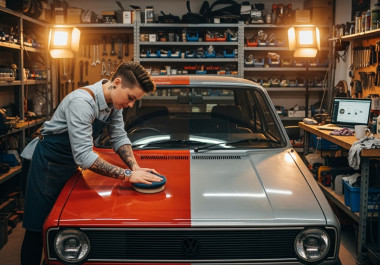The hammer drops. The car’s yours. Great feeling. Then the worry hits: what if the gearbox dies on the drive home? It’s the big auction question. The phrase "sold as seen" makes it sound like you're walking a tightrope without a net. But getting a warranty on an auction car isn't the impossibility most people think it is.
You just have to be smart about it. While you trade the hand-holding of a dealership for a better price, you’re not left completely in the cold. Protection often comes from two places: leftover coverage from the manufacturer or a separate plan from a third-party specialist.
Let's Get One Thing Straight About "Sold as Seen"
That phrase isn't a magic wand for sellers to wave away all responsibility. It simply means you're buying the car in its current condition, accepting the wear and tear that comes with its age and mileage. It puts the onus on the buyer to be satisfied before bidding.
But it doesn't mean you have to accept a car that's been misdescribed. Under UK law, goods must be "as described." If a listing says "no warning lights" and the dashboard lights up like a Christmas tree, that's a different problem. So, where can you find actual mechanical protection? The first, and best, place to look is with the people who built the car.
The Easiest Win: Leftover Manufacturer Warranty
The best warranty is the one you don't have to pay for. It’s surprising how many newer cars at auction are still under their original manufacturer’s warranty. This cover is tied to the car, not the owner, so it rolls right over to you.
How It Works
Most brands offer at least three years of cover from new. Some go much further—Kia’s seven-year warranty is a well-known perk, while Toyota offers up to ten years with its Relax programme. A two-year-old Ford Focus from an auction could easily have a year of its original warranty left. That’s a huge plus. It means if a major part fails, the bill goes to the manufacturer, not you. This typically covers the most expensive components like the engine, transmission, and major electronics, but not wear-and-tear items like brake pads, tyres, or clutch plates.
What You Must Check Before Bidding
Hold on, though. A manufacturer can and will scrap a warranty if the car hasn't been cared for. You need to check two things, no exceptions:
-
Service History: Is it complete and on time? A missing stamp or a service that’s 5,000 miles overdue can kill the warranty stone dead. Look for evidence that the correct grade of oil and approved parts were used.
-
The Fine Print: Check the mileage limit. A three-year, 60,000-mile warranty is useless if the car has done 65,000 miles. This is non-negotiable for manufacturers.
A five-minute call to a main dealer for that brand is invaluable. Give them the reg number, and they can tell you instantly if any cover is left.
How a Quick Phone Call Saves a Fortune
Think about this scenario: a buyer spots a sharp, two-and-a-half-year-old Mondeo at an auction. It’s an ex-fleet car, which can be a red flag for missed services. Before even thinking about a bid, the buyer rings the local Ford garage.
The garage confirms it has six months of warranty left, and the service history is all up-to-date on their system. Boom. Armed with that, the buyer bids with confidence. Two months later, the big touchscreen dies. A trip to the dealer and it's replaced under warranty. That single phone call saved an £800 bill.
But what if the car is older?
Turning to Third-Party Warranties
When the manufacturer's warranty is a distant memory, you look at third-party providers. Think of these as insurance policies for your car's mechanical bits. You pay a fee, and if a covered part fails, the warranty company pays for the repair, minus your excess.
Choosing the Right Plan
This market is a minefield. The quality of cover varies wildly, so you need to be sharp. Policies are generally tiered:
-
Basic Powertrain Cover: The cheapest option, usually covering only the core engine, gearbox, and drivetrain components. It’s a safety net for catastrophic failure but not much else.
-
Named Component Cover: A mid-tier plan that lists exactly which parts are covered. This will often include the basics plus specific electrical items like the starter motor, alternator, and key sensors. If a part isn't on the list, it isn't covered.
-
Exclusionary Cover: The most comprehensive (and expensive) type. These policies cover everything except for a specific list of excluded items. This is the closest you’ll get to a manufacturer-style warranty.
Always check the claim limits. A £1,000 limit per claim might not be enough for a major engine or gearbox repair on a premium German car. Also, check the provider's reputation online; a cheap policy is worthless if the company is known for rejecting claims.
Be Straight with Them
When applying for a third-party warranty on an auction car, tell them where you bought it. Some may require a pre-cover inspection from a garage. Hiding a known issue is just asking for a claim to be rejected down the line.
Do You Even Need a Warranty?
Before rushing out to buy a policy, ask yourself if it’s always the right move. The answer is no.
You have to do the maths. If you're buying a simple, older car for £1,500, a £300-a-year warranty probably doesn't make sense. You could just stick that money in a savings account for repairs. It all comes down to your appetite for risk. If the thought of a surprise £500 bill makes you nervous, a warranty is probably a good idea. If you're handy with a set of tools and are buying a model known for its reliability, you might decide to take your chances.
Your No-Nonsense Pre-Bid Checklist
Keep it simple. Here’s what to do before you bid:
-
Check the Car's Age: Under three years old? Investigate the manufacturer's warranty. It's the best cover you can get, full stop.
-
Dig into the Service History: A full service book is gold dust. No history means no manufacturer cover.
-
Research Early: Know which warranty companies you might use beforehand. Get quotes for the specific make and model you’re interested in.
-
Read the Small Print: Read the exclusions and claim limits before you pay. Understand what you are and are not covered for.
-
Factor in the Cost: A cheap car plus an expensive warranty isn't a bargain. Add the annual warranty cost to your total budget.
Final Thoughts: You're in Control
While RAW2K provides a transparent place to buy, arranging auction car coverage is down to you. "Sold as seen" doesn't mean you drive away exposed.
Focus on newer cars with a solid paper trail, and you can often bag a manufacturer's warranty. For older cars, a carefully chosen third-party plan can be a lifesaver. With a bit of prep, you can browse the available car auctions with the confidence of someone who's covered all the angles.




